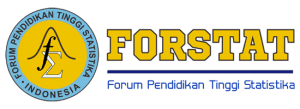PERBANDINGAN MATRIKS PEMBOBOT ROOK DAN QUEEN CONTIGUITY DALAM ANALISIS SPATIAL AUTOREGRESSIVE MODEL (SAR) DAN SPATIAL ERROR MODEL (SEM)
Abstract
The spatial weighting matrix is very important to overview of the relationship between one location to another in the spatial regression. In this study, the authors compare the weighting matrix of queen contiguity and rook contiguity in the SAR and SEM models in stunting cases in Bone Bolango Regency, Gorontalo Province. The variables used are the number of IDL, the percentage of LBW, the amount of proper sanitation, the percentage of exclusively breastfed babies, and the number of poor people. The purpose of this study was to determine the factors that influence stunting in Bone Bolango Regency, compare the results of the analysis of the rook contiguity and queen contiguity matrices in the SAR and SEM models and determine the best model and weighting matrix in stunting modeling in Bone Bolango Regency. The results showed that the significant factor in the SAR model was the number of poor people, while the significant factors in the SEM model were the number of IDL, the number of proper sanitation, and the percentage of exclusively breastfed babies. In the SEM model, the p-value of queen contiguity is smaller than that of rook contiguity.The best model in this study is the SEM model.
Keywords
Full Text:
PDFReferences
Afifah, S. . (2017), "Pemodelan Alokasi Persediaan Suku Cadang dengan Mempertimbangkan Pengaruh Spasial" ITS.
Angelia, I. O., dan Nurhafnita (2020), "Optimalisasi Pemanfataan Lahan Pekarangan Menggunakan Teknik Vertikultur untuk Budidaya Sayuran Pencegah Stunting Pada Balita Gizi Buruk" Jurnal Abdimas Gorontalo, 3, 42-45.
Dewi, V. N. (2016), "Model Estimation for Spatial SUR Panel Data (Case Study Sectoral Employment Model in Indonesia)" ITS.
Getis, A., dan Aldstadt, J. (2004), "Constructing the spatial weights matrix using local statistic" Geographical Analysis, 36, 90-104.
Kusrini, D. E., Suhartono, S., dan Sari, D. M. (2013), "Pemodelan Kasus Tindak Pidana di Kota Surabaya dengan Pendekatan Regresi Spasial" Jurnal Sains dan Seni ITS, 2, D135-D140.
Modjo, M. E., Setiawan, A., dan Susanto, B. (2019), "Identifikasi Autokorelasi Spasial Pada Laju Inflasi Di Indonesia Timur Menggunakan Lisa Bootstrap" in Konferensi Nasional Penelitian Matematika dan Pembelajarannya (KNPMP) IV, Surakarta.
Nur, D., Sari, E., Hayati, M. N., dan Wahyuningsih, S. (2020), "Model Spatial Autoregressive Moving Average (SARMA) pada Data Jumlah Kejadian Demam Berdarah Dengue (DBD) di Provinsi Kalimantan Timur dan Tengah Tahun 2016" Eksponensial, 11, 57-64.
Pemerintah Bone Bolango (2021), "Perbup Bonbol No. 77 th 2021 ttg Prcepatan Pnurunan & Pncegahan Stunting.pdf."
Samadi, H., Yudiantri, A., dan Efendi (2017), "Penerapan model regresi spasial dalam Menentukan Faktor-Faktor yang Mempengaruhi iIndeks Pembangunan Manusia di Kabupaten/Kota Provinsi Sumatera barat" Jurnal Matematika UNAND, VI, 80-89.
Sugiarti, N. (2013), "Pengujian Autokorelasi pada Model Regresi Spasial Lag dengan Statistik Uji Moran" UIN Maulana Malik Ibrahim Malang.
Sulistyawan, E., dan Mustika, R. (2019), "Spasial Error Model untuk Balita Gizi Buruk DI di Provinsi Jawa Timur Tahun 2016" Jurnal Riset dan Aplikasi Matematika (JRAM), 3, 57. https://doi.org/10.26740/jram.v3n1.p57-63.
DOI: https://doi.org/10.34312/jjps.v3i1.13582
Refbacks
- There are currently no refbacks.
Copyright (c) 2022 Jambura Journal of Probability and Statistics

This work is licensed under a Creative Commons Attribution-NonCommercial 4.0 International License.







.jpg)






